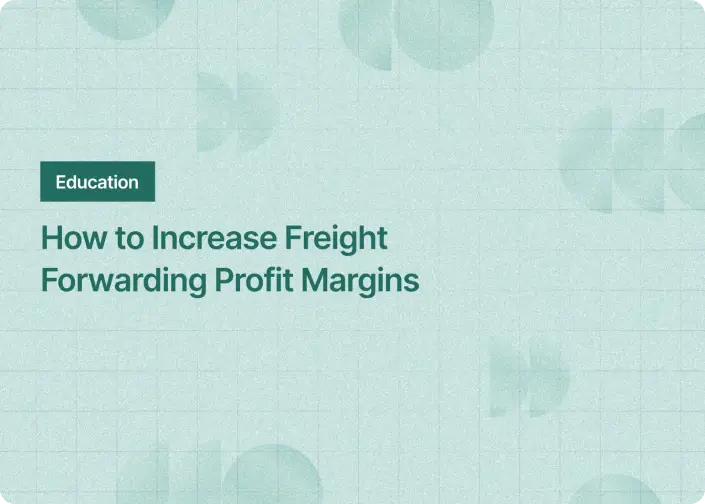40%, a pretty high profit margin achieved by the top 5 freight forwarding companies. However, most freight forwarding companies have profit margins of only 6-10%. You may be wondering what you need to do to increase the percentage of your freight forwarding profit margins. With rising competition in the freight forwarding industry, most forwarders’ profit margins are shrinking. Today, a forwarder must execute many more orders to maintain the target profit margin. For example, if a forwarder needed to close 100 orders before in order to meet his targets, he would need to close 120 orders today. This means that in order to handle more shipments, you will need to enhance and accelerate all freight forwarding operations. In addition, because the amount you can charge for freight forwarding service is limited, the other way to increase your profit margins is to cut costs. The key to becoming more profitable for your business is to reduce costs, keep costs low, or maintain costs over time.
Handling more shipments to increase profit margins
Better planning and workflow automation appear to be essential, so why are so many forwarders still using paper folders, excel sheets, and handwritten notes? It’s not that freight forwarding technology doesn’t exist; it’s just that people are reluctant to digitize their operations. According to a DHL report on supply chain digitization, 68 percent of respondents questioned technology’s reliability and their organizations were resistant to change. Implementing a new software solution may appear to be a hassle because it takes time to learn and fully integrate the system into your daily operations. However, the gained efficiency completely offset the effort of deploying a new system.
![]()
Save 3 hours a day for a 6-person team
A freight forwarder spends an average of 30 minutes manually entering shipment data from various media. And many times, these orders are repeated, coming from the same customer. Using freight forwarding software, information from previous orders is saved, and repeated data entries are automatically filled. EDI is also used, removing the need for forwarders to manually check shipment status on carrier websites. These allow forwarders to save at least three hours per day for a six-person team and focus on receiving more orders.
Increasing customer satisfaction
If your problem is that you are not receiving enough orders while your work capacity is still not at its maximum, you may want to look into customer satisfaction. Freight forwarding is a business that relies heavily on returning customers, and if your customers are dissatisfied with your service, they can easily find another forwarder to work with. Clients frequently become dissatisfied with their forwarders because many forwarders spend insufficient time cultivating relationships with their customers. As a result, when customers have a bad experience, they leave negative comments on Google or Yelp reviews, which can seriously harm your online reputation. If potential customers do read online reviews before deciding to work with you, a poor reputation could have a significant impact on the number of orders you receive in the future. Responding to customer inquiries as quickly as possible and providing accurate shipment status information are two ways to increase customer satisfaction. Don’t wait until your clients ask for updates on the status of their shipments. Notify your clients immediately if the shipment status changes.

Reducing Costs
Choosing the right partner
A freight forwarder works with a variety of service providers, including carriers, truckers, warehouses, and others. It is critical for a freight forwarder to have a person or team in charge of procuring these services in order to optimize the cost ratio and provide a competitive quote with good quality. Finding the right balance of service coverage, cost, and reputation will help you run your business more effectively.
Implementing a Real-time Tracking System
The majority of the tracking information provided by your carriers is not real-time, and the shipment status can be very inaccurate. Shipments that have been held at the port for days or even weeks are quite common in the industry. Many freight forwarders suffer significant detention and demurrage costs simply because they do not know when their shipments arrive at port. This is the problem that a real-time tracking system aims to solve, alleviating freight forwarders’ tracking pains. To ensure maximum precision of shipment status information, the most advanced real-time container tracking system, such as GoFreight, cross-references data from multiple sources, such as terminals and carriers.
Avoiding Human Errors
No forwarder can claim to have never made an error in their daily operations. However, the ability to avoid or quickly recover from human errors is essential to increasing your profit margins. Human errors can manifest themselves in a variety of ways, including incorrect quotations, improper cargo packing, incorrect documentation, and so on. Obviously, using tried-and-true processes and hiring the right people with relevant experience can help to avoid costly mistakes. Using freight forwarding software, on the other hand, could greatly reduce human errors by automating workflows that help prevent double data entry, generate quotations, prioritize important tasks, and much more.

Freight Forwarding Software Can Help You Handle More Shipments and Reduce Cost
As mentioned in other parts of this article, freight forwarding software can help you in a variety of ways. If used correctly, freight forwarding software could be the solution for you to increase your profit margins. If you’d like to learn more about how modern freight forwarding software like GoFreight can help accelerate your business growth, please contact us to set up a free demo.



